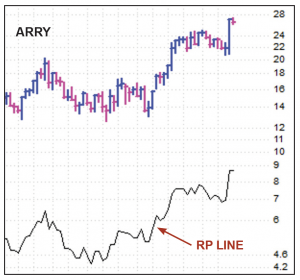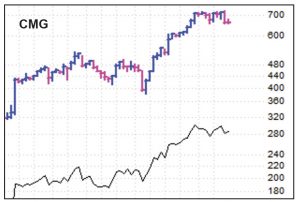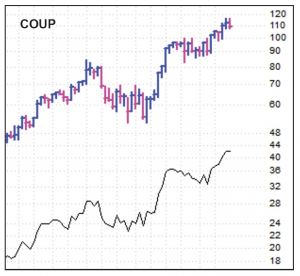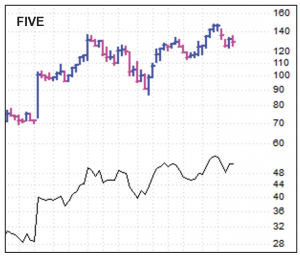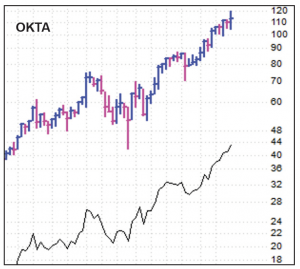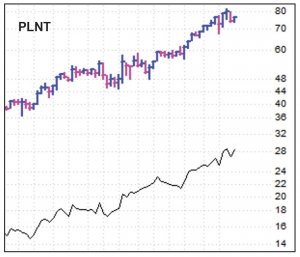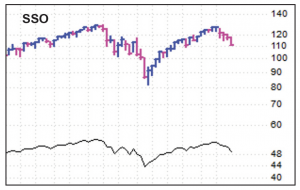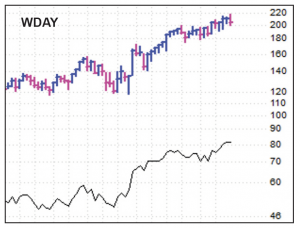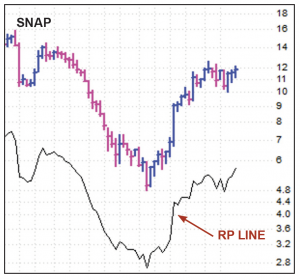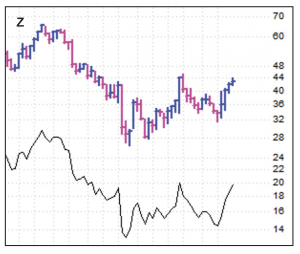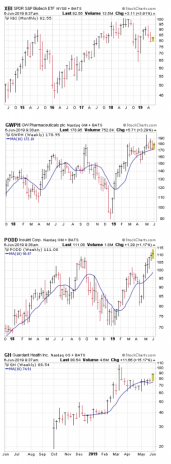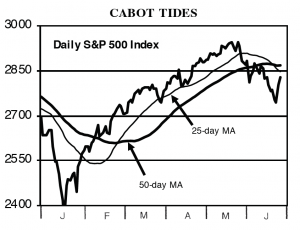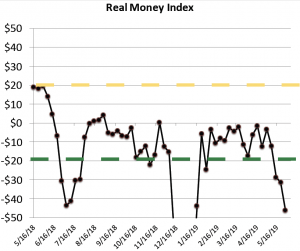The market remains in a correction, and with the intermediate-term trend pointed down, we’re still advising a cautious stance. That said, we do think the pieces are in place for a new advance, from positive longer-term evidence, a big dip in sentiment and bullish action from many leading growth stocks.
In tonight’s issue we review all of our stocks, fine tune our watch list and we also look at the medical sector, which we think could be a leadership area going forward for a few reasons.
Cabot Growth Investor 1421
[premium_html_toc post_id="178920"]
Pieces are in Place
We’re about five weeks into this market correction, and it’s been a pretty nasty one when looking at the major indexes—from high to low, the S&P 500 has fallen as much as 7.6% and the Nasdaq by 10.8%, with small- and mid-cap indexes sinking 9% to 10%. And, as we saw on Monday, even the market’s sacred cows (many well-loved mega-cap tech stocks) were taken to the woodshed.
All told, with our Cabot Tides still clearly negative and most stocks in intermediate-term downtrends, we’re still advising caution. But we’re not running for cover—in fact, we’re keeping our eyes peeled because we think the pieces are in place for a new uptrend to get underway.
We say that for three reasons. First, the longer-term evidence is still positive on a variety of fronts. Not only did our Cabot Trend Lines remain bullish (by a hair) last week, but the S&P’s downmove continues to fit within the parameters of a “normal” first correction in a blastoff environment. (See our write-up for SSO on page 3 for a bit more on that.)
Second, the five-week downmove, combined with a rash of fundamental worries, has definitely turned sentiment pretty bearish. For instance, our Real Money Index has moved further into positive territory, with last week showing a whopping $22 billion outflow from equity funds, one of the largest figures in years. And the four-week average of AAII’s survey of individual investors shows bearishness at similar levels to past market lows.
And third, while Monday was ugly, many leading growth stocks continue to hang in there overall; encouragingly, a bunch have raced higher as soon as the pressure came off the market Tuesday and Wednesday, a good sign buyers are still lurking.
None of this means the correction is necessarily over—until our Tides turn green, we’re not going to get giddy. Remember that, in the market, good stocks can go bad in a hurry in downtrends, so it’s best not to ignore the message of the market’s trend.
But having boosted our cash position north of 40% over the past few weeks, we’re going to redeploy a little of that tonight and keep our eyes open for signs the bulls are retaking control.
[highlight_box]WHAT TO DO NOW: Remain cautious, but don’t get overly defensive. In the Model Portfolio, we’ve sold our stake in Workday since the last issue, but tonight, we’re going to put that back to work, buying half positions in Array Biopharma (ARRY) and Coupa Software (COUP). Our cash position will be around 32%.[/highlight_box]
Model Portfolio Update
Thanks to the resilience of many stocks and some maneuvering on our part, the Model Portfolio remains in solid shape, still up more than 17% for the year. Given the damage in the market, that’s good to see, but we remain focused on staying in gear with the evidence.
Having let go of the rest of our Workday position on Monday evening, the portfolio is now 42% in cash, and with our Cabot Tides still negative, we’re content to hold most of that until the trend turns back up. However, as we did on the way down, we’re not opposed to massaging our exposure based on the evidence—and given some of positive secondary measures and solid action in growth stocks, we’re redeploying a little cash tonight, adding half positions in ARRY and COUP.
Even after the buys, the portfolio is still around one-third in cash, so we’re not pounding the bullish table. From here, we’ll be watching our stocks and indicators closely, and will need to see clear improvement (Tides positive and/or a rash of fresh breakouts among growth stocks) to extend our line.
Current Recommendations
BUY A HALF—Array Biopharma (ARRY 29)—As we write on page 6, we’re increasingly attracted to medical stocks, as most (a) are acting well, (b) have enticing growth stories (not just speculative development stage firms) and (c) a lot of their growth is under their own control (not tariffs, the Fed, China, etc.). Array is one of our favorites, with a couple of drugs (Braftovi and Mektovi) that hit the market last year, approved for the treatment of melanoma patients with a common genetic mutation; in Q1, they brought in $35 million in revenue, which was well ahead of estimates. And, soon, these two could be used in a combination therapy to treat certain colorectal cancer patients that have no currently approved treatments; recent data showed excellent response rates and reduction in the risk of death. (Array anticipates submitting the data to the FDA in the second half, with approval anticipated by year-end.) Many analysts see the opportunity for these two drugs in melanoma alone at $500 million to $1 billion, with colorectal cancer providing similar sales potential. All told, analysts see revenue rising 61% this year and another 32% next, but those could prove conservative depending on how fast Array can sell into the market. The stock is certainly expecting big things—after a good start to the year, ARRY sagged for a few weeks starting in April, but the good clinical data has lit a fire under the stock. It’s extended, but we think there will be good support in the mid 20s should the market fall back. We’re buying a half-sized (5% of the portfolio) position here.
HOLD—Chipotle Mexican Grill (CMG 692)—Chipotle Mexican Grill got caught up in the trade war selling late last week before bouncing back. Fundamentally, it doesn’t look like the potential tariffs on Mexican goods (which may or may not go into effect) are that big a deal. If they became permanent, costs would rise by about $15 million this year (call it 50 cents per share), which could be offset by raising the price of its burritos by a nickel each. Of course, the company is not the stock, so we’re keying off the action, but to this point the correction is acceptable—CMG fell a maximum of just 11% or so from its peak, which is reasonable given its prior run. Bottom line, we’re sticking with a mental stop in the mid 620s, as a drop to there would look a bit abnormal on the chart and eat into most of our profits. For now, though, we advise patience—the recent rebound has been encouraging and we still think CMG’s next major move is likely to be up.
BUY A HALF—Coupa Software (COUP 118)—We don’t want to get too heavy in software stocks, but having booked our modest gain in Workday, we’re OK starting a position in Coupa, a stock we’ve followed for months and, as we’ve written before, has one of our favorite stories. The company’s cloud platform looks like the hands-down leader for business spend management, which is about as mass market a product you’re going to get in the business world. Since its launch, Coupa’s platform has processed $1.2 billion in payments; that figure is up $450 billion from the year before, and all that spending has led to proprietary data and knowhow that keeps Coupa well ahead of the competition. (The firm said it’s taking on some very complex, multinational, multi-currency, multilingual installations, so it’s clear the industry sees Coupa as the gold standard.) Management has a goal of $1 billion in annual revenue down the road (triple its current run rate), and there’s little doubt it will get there—in Q1, the top line grew 44%, which was miles above estimates (subscription revenues were up 46%), while billings leapt 50% and deferred revenue rose 45%. Better yet, the bottom line was in the black (three cents per share), and free cash flow came in at a whopping 20% of revenue in the quarter. The stock fell to its 50-day line (and prior support near 100) during Monday’s market wipeout, but after earnings, it ripped higher on its heaviest volume in more than two years. The company is set to sell a good-sized (and dilutive) convertible bond offering, which could possibly dent the stock when it’s priced, but today the stock actually rose despite that news, which is a rare show of strength. We’re OK grabbing a half-sized position here.
HOLD—Five Below (FIVE 122)—Five Below reported another fine quarter last night, with revenues up 23%, earnings of 35 cents matching expectations and same-store sales growth of 3.1%, which was a bit below expectations. Management sounded all the right notes when it came to the future, with continued best-in-class store productivity and optimism when it came to offsetting 25% tariffs from Chinese imports. That said, the stock remains weak—today, in fact, shares toyed with their 200-day line for the first time since last December. Because the stock is still effectively in a wide trading range that began last September (there’s some support in the mid 110s), and since we have a small-ish position (5% of the portfolio), we’re going to hold onto FIVE to see if it can rebound following today’s earnings drop, a pattern that’s been seen in many growth stocks during the past couple of months. But our leash is fairly tight—after months of up-and-down action, we think the stock should find support soon if it’s going to be a leader going forward. If it doesn’t, we’ll take the remaining portion of our big profit and move on to greener pastures. We’ll be watching.
BUY—Okta (OKTA 124)—Okta reported another terrific quarter late last week, not only topping expectations but confirming that its growth potential remains enormous as the need for identity solutions should continue to mushroom. In the quarter, the firm’s revenues leapt 50% (including a 52% gain in subscription revenue), billings rose 53% and, while earnings were in the red, free cash flow came in at $13 million, or more than 10% of revenue. Beyond that, Okta signed 450 new customers (total customer count was up 7.4% from the prior quarter), including a bunch of big ones; customers that are paying Okta at least $100,000 annually boomed 53%. Additionally, same-customer revenue growth rate came in at 19% (and the company expects continued growth in the 15% to 20% range), so you know current clients are signing on for more services. Beyond the numbers, though, is the opportunity: Security is now a “zero trust” (Okta’s words) endeavor, as organizations must never trust and always verify users to prevent breaches. Okta’s platform is perfect for that, so if management pulls the right levers, there’s no reason the company can’t grow rapidly for years as more clients sign up, as current clients expand their usage, as workforces become more mobile and as the cloud becomes the norm. OKTA popped after its report despite an awful market environment late last week and zoomed to new highs today. We’ll stay on buy, but recommend that you keep any new positions small and try to buy on dips of a couple of points.
BUY—Planet Fitness (PLNT 79)—On one hand, PLNT looks a bit tired, having suffered some big-volume selling in mid-May following a few months with basically zero pullbacks (except a one-day, post-earnings shakeout a month ago). On the other hand, shares are still north of its 50-day line and the stock still looks like relatively rare merchandise, being one of the only national gyms that caters to the mass market, with years of growth ahead. The company presented at a conference this week, though it didn’t break much new ground; the firm is still looking at a total potential market of 4,300 locations (4,000 in the U.S., 300 in Canada), compared to 1,806 at the end of March, with buoyant same-store sales growth (high single digits this year) and cash flow growth this year. A drop below the 73 to 74 area could have us moving to Hold, but with the uptrend intact, we’ll stay on Buy.
HOLD—ProShares Ultra S&P 500 Fund (SSO 118)—The S&P 500’s low on Monday was 7.6% below its May 1 high, which is acceptable when looking at the Cabot Trend Lines (still bullish), when compared to the 90% Blastoff signal from February 20 (2% below that signal, which is in line with historical drawdowns), and when compared to other initial corrections following 2-to-1 Blastoff signals (usually 5% to 9%, with bigger pullbacks coming after bigger upmoves like we saw this year). We review all of that not to overanalyze the past few weeks but to develop a game plan, so here it is: Any meaningful and sustained drop below this week’s lows would probably have us selling another chunk of our SSO position, as that would raise the specter of an “abnormal” correction. But until then, we’re comfortable holding onto our shares, as the odds still favor this correction leading to nicely higher prices down the road.
HOLD—Twilio (TWLO 140)—TWLO has been all over the map in recent weeks (142 to 123 to 145 to 124 and now back into the upper 130s, all in the past month!), but taking a step back, there’s little question the stock remains resilient—it’s been etching higher lows in recent weeks despite the market and a good-sized share offering. There’s been nothing much new from the company, but the overall story, the numbers released in Q1’s report a few weeks back and the chart’s resiliency continue to tell us that this remains one of the leading stocks out there today. Obviously, if the market has another big leg lower, TWLO could easily go along for the ride, but having already sold one-third of our initial position, we’re continuing to give our remaining position plenty of leeway. Until proven otherwise, we see TWLO as an institutional favorite that should do well whenever this correction finishes up.
SOLD—Workday (WDAY 204)—We have nothing greatly against WDAY; it’s certainly not the worst chart out there, and business-wise, the company is doing fine. But our biggest thought with WDAY is that it’s not a real leader—after the recent drop, it’s no higher now than it was in late February, even as many cloud software peers remain resilient. We wouldn’t be surprised to see it do fine going forward, but we decided to take our profit (in two stages—half last week, half on a special bulletin Monday evening) and move on.
Watch List
DocuSign (DOCU 55): DOCU got smacked around earlier this week, but still held within its range. Earnings, due out tonight, will probably tell the tale—a breakout above 60 down the road would be very enticing.
Roku (ROKU 100): ROKU remains one of the strongest growth stocks in the market, barely hiccupping during the recent market pressures. It’s the #1 play on cord-cutting and over-the-top TV services.
Shopify (SHOP 297): So far, with all the selling in the market and (earlier this week) in growth stocks, the bears could only manage to pull SHOP down to its 25-day line. It continues to look like a liquid leader to us.
Snap (SNAP 14): It’s a bit more of a turnaround, but after a couple of years in the wilderness, user growth has returned and ad tools are boosting monetization. The stock actually lifted to new highs on Tuesday. See more below.
Tandem Diabetes (TNDM 71): TNDM is sitting near the top of a nice-looking 11-week base. It’s one of many strong medical stocks, and while it’s volatile, we think the company’s insulin pump has huge potential.
Other Stocks of Interest
The stocks below may not be followed in Cabot Growth Investor on a regular basis. They’re intended to present you with ideas for additional investment beyond the Model Portfolio. For our current ratings on these stocks, see Updates on Other Stocks of Interest on the subscriber website or email mike@cabotwealth.com.
Snap (SNAP 14)— In recent years we’ve seen many heavily hyped IPOs come public, crash for a few months or even years, but then eventually come back into the market’s good graces; Facebook was the classic example, and Twilio followed a similar path. Snap may be the next in line, and while it’s highly unlikely to be the next Facebook, it could be the next Facebook for Millenials and Generation Z—in fact, Snapchat now reaches 75% of 13- to 34-year-olds in the U.S., which is larger than even Instagram. It does this through a variety of relatively goofy (but fun) camera-based products. In addition to its core Lenses offering, it also has Scan, which can recognize what a camera is looking at, while Landmarkers will recognize popular buildings and landmarks and let users, say, land a dragon on one of them—as well as other content (games, collections of photos and videos, etc.). As with Twitter, the prime fear here is the rate of user growth, but investors think some new blood (much of the management team has been revamped in recent quarters) and product innovation (its new Android app is 20% faster and takes up 25% less space, with early indications showing rising engagement) could change that. Indeed, in Q1, daily active users totaled 190 million, up four million from Q4 and ahead of estimates, while ever-improving ad tools boosted monetization; all told, Q1’s revenues lifted 39%, and while earnings are in the red, free cash flow was positive. Impressively, the stock had a huge, persistent rally from 5 to 12.5, consolidated normally even while the market has tanked and has lifted to new highs this week.
Axon Enterprises (AAXN 68)—Axon (formerly known as Taser) popped up on our screens last year as the company began transitioning away from simple weapon sales and adding a software-based business model—its platform can take in video from body cameras and allow law enforcement personnel to store, edit, share and analyze evidence in the cloud. Even the firm’s new Tasers come with a bundle package (includes training and unlimited cartridges), continuing the move to a recurring-revenue business model. The tricky part is that weapon sales still make up the majority of sales, and those can be lumpy and, in general, aren’t showing great growth (up a mere 3% in Q1). But as time goes on, Axon is being judged more on its recurring business metrics, and those are looking great; annualized recurring revenue under contract came in at $122 million in Q1, up 47% from a year ago, while total contracted future revenue was $930 million, up 43%. Indeed, while earnings have slipped each of the past two quarters, analysts see that turning around, with total revenues (even including Taser sales) up in the mid teens, and earnings likely to leap north of 30% both this year and next. To be fair, management here has a so-so history in terms of making the right moves, but fundamentally they seem to be pulling the right levers of late. As for the stock, its five-month run last year took it from 30 to 76 before it stumbled back to 40 by year’s end. But AAXN has pushed steadily higher this year, and we’re impressed by the relatively calm, tight action in recent weeks, despite the awful market.
Zillow (Z 47)—We’ve followed Zillow off and on for years, as it’s the clear leader in eyeballs for real estate listings, which in the past, has made it a magnet for advertising from real estate agents. That’s still a big business ($218 million in revenue from its Premier Agent segment in Q1), though growth has slowed with the housing market (up just 2%). Instead, the stock is perking up due to some of its newer businesses—rentals grew 30% last quarter, while mortgage revenue lifted 44%. But the really big deal is Zillow Offers, where the company directly buys houses from customers (for prices that, based on its myriad data, it feels to be advantageous), does some work if necessary and then resells down the road. Wall Street was very skeptical of the move when it was originally announced last year, but the first quarter showed great progress—Zillow purchased 898 homes, sold 414 and brought in $129 million in revenue, with cash flow nearly breakeven for this new endeavor. And that’s just the beginning, with management seeing this quarter’s home sales revenue rising to $240 million or so, and expects to have Offers up and running in 20 markets by the end of next year. Of course, new business line or not, Zillow is still going to be tied to the housing market, so if home sales turn down, that will affect the company’s outlook. But right now, the housing market is actually showing some signs of coming out of a yearlong funk, and any monetary easing could help that. As for Z’s chart, it’s not quite set up yet, but it’s shown big-volume buying over the past few weeks even as the market slid. We’re intrigued.
Medical Looks Like New Leadership
There’s no doubt we’ve had a relatively serious market correction. When you get a dip this sharp, there are often new leaders that take the baton during the next uptrend. Today, we’re thinking the broad medical sector—including some biotech, medical devices and even medical testing companies—has a good chance of producing some nice winners during the next upleg.
Part of the reason we say that is because we’re seeing more and more names set up nicely in spite of the straight-down market of the past few weeks; more on that in a second. But there are two other major factors: First, fundamentally, many of these companies not only have great stories but their business isn’t overly sensitive to the whims of tariffs and economic wobbles, which is a plus in this environment. And second, the sector as a whole isn’t as “hot” and overplayed as some other areas.
In fact, the chart of the S&P Biotech ETF (XBI), which is a diversified medical fund (its biggest position is less than 2% of assets), tells the long-term tale; XBI has had some downs and ups over the past few years, but net-net, it’s no higher now than it was back in early 2015, four years ago. That doesn’t guarantee anything, but it’s clear the sector isn’t chock-full of weak hands.
Digging into individual stocks, we’re impressed with the breadth of enticing stories in the group, as well as some real growth numbers (at least on the sales side). Array Biopharma (ARRY) looks like a possible leader—it’s already at new highs thanks to excitement surrounding its Braftovi and Mektovi treatments for melanoma and (soon) certain colorectal cancer patients. We wrote about it on page 4 of the last issue and are adding a half-sized stake to the Model Portfolio tonight.
GW Pharma (GWPH) has set up a nice base and, fundamentally, looks set to ride Epidiolex, a cannabinoid-based drug that’s approved for a couple of congenital seizure conditions, with approval for Tuberous Sclerosis likely in the near future. There are many off-label uses, too, as well as more label expansions possible down the road. Earnings are deep in the red, but analysts see the top line hitting $168 million this year and $475 million (!) next.
Another area of strength is in insulin pumps. We’ve written about Tandem Diabetes (TNDM) before, and it’s still a stock we like, with triple-digit revenue growth and a nice launching pad. (It’s on our watch list.) A peer in the same space is Insulet (PODD), whose latest Omnipod pump (tubeless, waterproof, Bluetooth enabled) and Dash insulin management system (control everything from your smartphone) should drive solid sales (20%) and earnings (faster) growth. And the stock has been nudging into new high ground in recent weeks.
Then there are some testing stocks—old friend Exact Sciences (EXAS) remains wild, but its push back toward its old highs is a good thing. And then there’s recent IPO Guardant Health (GH), which looks like a leader in liquid biopsy tests (instead of more costly, risky and painful tissue biopsies) that detect cancer in high-risk patients. Its platform is used by both pharma and clinical customers, and sales growth has been outstanding (up 120% in Q1). The stock had a huge post-IPO boomlet, but after settling back for a couple of months, has tightened up and begun to perk up.
Of course, there’s nothing that says these resilient medical stocks can’t attract the attention of the bears before this correction finishes up. But so far, five weeks into this correction, many fundamentally attractive medical names are holding up and, in some cases, already moving to new highs.
Cabot Market Timing Indicators
The intermediate-term trend remains clearly down, and at Monday’s low, the market was right on the edge of what we’d consider a “normal” correction. That said, many secondary measures are encouraging and a bunch of growth stocks still act well. We’re cautious overall (one-third in cash) but aren’t opposed to a little new buying.
Cabot Trend Lines: Bullish
The Cabot Trend Lines remain bullish, as last Friday both the S&P 500 (by 0.1%) and Nasdaq (by 0.4%) closed a hair over their respective 35-week lines last week. Like some other measures, the action is “normal” so far, but the next couple of weeks will be key. We don’t anticipate things, though, so until proven otherwise, the longer-term trend remains positive.
Cabot Tides: Bearish
Our Cabot Tides remain clearly bearish, with all five indexes we track (including the S&P 500, daily chart shown here) below their lower (now 25-day) moving averages. After a horrid month, there are some signs that the market could be sold out on a near-term basis, but there’s work to do for the intermediate-term trend to turn back up.
Cabot Real Money Index: Positive
It took a few weeks, but investors have begun to hit the eject button en masse. Our Real Money Index is still in positive territory and we’re now seeing outflows from equity funds and ETFs hit nosebleed levels—$46 billion has been yanked out of the market during the past five weeks, including $22 billion last week alone, which is the fifth highest weekly outflow in nearly two years. It’s a secondary indicator, but generally portends good things when looking out a month or two.
[premium_html_footer]
Send questions or comments to mike@cabotwealth.com.
Cabot Growth Investor • 176 North Street, Post Office Box 2049, Salem, MA 01970 • www.cabotwealth.com
All Cabot Growth Investor’s buy and sell recommendations are made in issues or updates and posted on the Cabot subscribers’ website. Sell recommendations may also be sent to subscribers as special bulletins via email and the recorded telephone hotline. To calculate the performance of the portfolio, Cabot “buys” and “sells” at the midpoint of the high and low prices of the stock on the day following the recommendation. Cabot’s policy is to sell any stock that shows a loss of 20% in a bull market (15% in a bear market) from our original buy price, calculated using the current closing (not intra-day) price. Subscribers should apply loss limits based on their own personal purchase prices.
Charts show both the stock’s recent trading history and its relative performance (RP) line, which shows you how the stock is performing relative to the S&P 500, a broad-based index. In the ideal case, the stock and its RP line advance in unison. Both tools are key in determining whether to hold or sell.
THE NEXT CABOT GROWTH INVESTOR WILL BE PUBLISHED JUNE 20, 2019
We appreciate your feedback on this issue. Follow the link below to complete our subscriber satisfaction survey: Go to: www.surveymonkey.com/marketlettersurvey
Neither Cabot Wealth Network nor our employees are compensated by the companies we recommend. Sources of information are believed to be reliable, but are in no way guaranteed to be complete or without error. Recommendations, opinions or suggestions are given with the understanding that subscribers acting on the information assume all risks. © Cabot Wealth Network. Copying and/or electronic transmission of this report is a violation of U.S. copyright law. For the protection of our subscribers, if copyright laws are violated, the subscription will be terminated. To subscribe or for information on our privacy policy, call 978-745-5532, visit www.cabotwealth.com or write to support@cabotwealth.com.
[/premium_html_footer]



